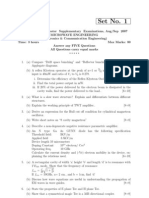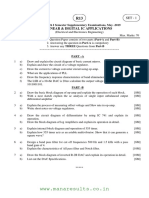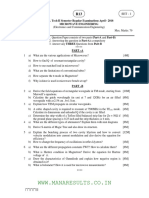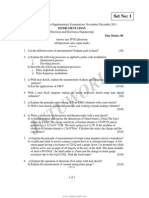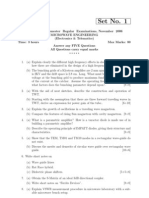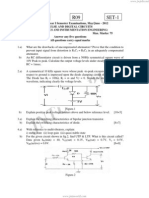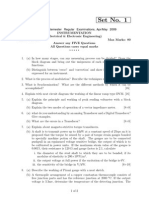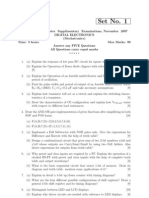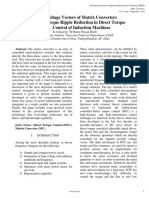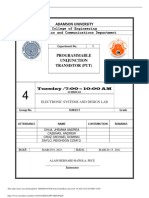0 ratings0% found this document useful (0 votes)
43 viewsRT31041042019 PDF
RT31041042019 PDF
Uploaded by
Katta VenkateshThis document contains questions for an exam on pulse and digital circuits.
It begins with Part A which contains short answer questions about common pulse signals, synchronized clamping, rise and fall times, using an astable multivibrator as a voltage-to-frequency converter, and the basic principle of bootstrap time base generators.
Part B contains longer answer questions about using an RC circuit as an integrator, calculating the output of a high pass circuit with a 10 kHz square wave input, types of clipper circuits, designing a diode clamper circuit, applications of voltage comparators, junction diode switching times, explaining an ECL circuit, the principle of bi-stable multivibrators, analyzing the timing of a bi-
Copyright:
© All Rights Reserved
Available Formats
Download as PDF, TXT or read online from Scribd
RT31041042019 PDF
RT31041042019 PDF
Uploaded by
Katta Venkatesh0 ratings0% found this document useful (0 votes)
43 views1 pageThis document contains questions for an exam on pulse and digital circuits.
It begins with Part A which contains short answer questions about common pulse signals, synchronized clamping, rise and fall times, using an astable multivibrator as a voltage-to-frequency converter, and the basic principle of bootstrap time base generators.
Part B contains longer answer questions about using an RC circuit as an integrator, calculating the output of a high pass circuit with a 10 kHz square wave input, types of clipper circuits, designing a diode clamper circuit, applications of voltage comparators, junction diode switching times, explaining an ECL circuit, the principle of bi-stable multivibrators, analyzing the timing of a bi-
Original Title
RT31041042019.pdf
Copyright
© © All Rights Reserved
Available Formats
PDF, TXT or read online from Scribd
Share this document
Did you find this document useful?
Is this content inappropriate?
This document contains questions for an exam on pulse and digital circuits.
It begins with Part A which contains short answer questions about common pulse signals, synchronized clamping, rise and fall times, using an astable multivibrator as a voltage-to-frequency converter, and the basic principle of bootstrap time base generators.
Part B contains longer answer questions about using an RC circuit as an integrator, calculating the output of a high pass circuit with a 10 kHz square wave input, types of clipper circuits, designing a diode clamper circuit, applications of voltage comparators, junction diode switching times, explaining an ECL circuit, the principle of bi-stable multivibrators, analyzing the timing of a bi-
Copyright:
© All Rights Reserved
Available Formats
Download as PDF, TXT or read online from Scribd
Download as pdf or txt
0 ratings0% found this document useful (0 votes)
43 views1 pageRT31041042019 PDF
RT31041042019 PDF
Uploaded by
Katta VenkateshThis document contains questions for an exam on pulse and digital circuits.
It begins with Part A which contains short answer questions about common pulse signals, synchronized clamping, rise and fall times, using an astable multivibrator as a voltage-to-frequency converter, and the basic principle of bootstrap time base generators.
Part B contains longer answer questions about using an RC circuit as an integrator, calculating the output of a high pass circuit with a 10 kHz square wave input, types of clipper circuits, designing a diode clamper circuit, applications of voltage comparators, junction diode switching times, explaining an ECL circuit, the principle of bi-stable multivibrators, analyzing the timing of a bi-
Copyright:
© All Rights Reserved
Available Formats
Download as PDF, TXT or read online from Scribd
Download as pdf or txt
You are on page 1of 1
Code No: RT31041 R13 SET - 1
III B. Tech I Semester Supplementary Examinations, May- 2019
PULSE AND DIGITAL CIRCUITS
(Common to Electronics and Communication Engineering and Electronics
and Instrumentation Engineering)
Time: 3 hours Max. Marks: 70
Note: 1. Question Paper consists of two parts (Part-A and Part-B)
2. Answering the question in Part-A is compulsory
3. Answer any THREE Questions from Part-B
~~~~~~~~~~~~~~~~~~~~~~~~~~~~~~~~~~~~~~~~~~~~~~~~~
PART –A
1 a) Name the signals which are commonly used in pulse circuits and define any five of [3M]
them.
b) What is synchronized clamping. [3M]
c) What are the reasons for existence of rise time and fall time? [4M]
d) Explain the application of Astable Multi Vibrator as a Voltage to Frequency Converter. [4M]
e) What is the basic principle of Bootstrap time base generator? [4M]
f) Define Relaxation circuit? Give Some examples. [4M]
PART -B
2 a) Prove that an RC circuit behaves as a good integrator if RC > 15T, where T is the [8M]
period of an input signal.
b) A 10 kHz symmetrical square wave whose peak to peak amplitude is 2V is impressed [8M]
upon a high pass circuit whose lower 3dB frequency is 5Hz. Calculate and sketch the
output waveform in particular what is the peak to peak amplitude.
3 a) What is a clipper circuit? Mention the types of clippers circuits. [8M]
b) Design a diode clamper circuit to clamp the positive peaks of the input signal at zero [8M]
level. The frequency of the input signal is 500 Hz.
c) Explain the applications of voltage comparators. [8M]
4 a) Explain in detail the junction diode switching times. [8M]
b) Draw and explain the circuit diagram of ECL. [8M]
5 a) Explain the principle of operation of Bi-stable multivibrators. [8M]
b) A fixed bias Bi-stable multivibrator circuit uses a DC supply of ±12 V, RC=2kΩ, [8M]
R1=10kΩ and R2=47kΩ. NPN silicon transistor with VCE(sat) = 0.1 V, VBE (sat) = 0.7 V
and hFE (min)=30 are used.
6 a) What are the different methods of generating time-base waveforms? Explain about [8M]
each briefly.
b) Explain the working of a transistor Bootstrap sweep circuit and derive expression for [8M]
the slope sweep error.
7 a) Define the three errors that occur in a sweep circuit and obtain an expression for these [8M]
errors for an exponential sweep circuit.
b) What is the principle of synchronization? Explain the method of pulse synchronization. [8M]
of relaxation devices with examples.
*****
www.manaresults.co.in
You might also like
- WWW - Manaresults.co - In: Pulse and Digital CircuitsDocument1 pageWWW - Manaresults.co - In: Pulse and Digital CircuitsKatta VenkateshNo ratings yet
- Microwave EngineeringDocument4 pagesMicrowave EngineeringUday RokxNo ratings yet
- Power Electronics May 2017Document2 pagesPower Electronics May 2017Timothyguriajal SaiNo ratings yet
- Code - No: 25042: Freespace Guide CutoffDocument8 pagesCode - No: 25042: Freespace Guide CutoffSRINIVASA RAO GANTANo ratings yet
- Mwe 16 SDocument1 pageMwe 16 SpriyaNo ratings yet
- Rr311701 Microwave EngineeringDocument8 pagesRr311701 Microwave EngineeringSrinivasa Rao GNo ratings yet
- JNTU Old Question Papers 2007Document7 pagesJNTU Old Question Papers 2007Srinivasa Rao G100% (12)
- III B. Tech I Semester Regular/Supplementary Examinations, October-2016 Power ElectronicsDocument6 pagesIII B. Tech I Semester Regular/Supplementary Examinations, October-2016 Power ElectronicssixfacerajNo ratings yet
- Microwave EngineeringDocument5 pagesMicrowave EngineeringHarikrishna KhariduNo ratings yet
- Microwave Engineering November Am Rr311701Document8 pagesMicrowave Engineering November Am Rr311701Nizam Institute of Engineering and Technology LibraryNo ratings yet
- rr320403 Electronic Measurements - InstrumentationDocument8 pagesrr320403 Electronic Measurements - InstrumentationSRINIVASA RAO GANTANo ratings yet
- Code No: 37041/37042Document6 pagesCode No: 37041/37042SRINIVASA RAO GANTANo ratings yet
- Pulse and Digital CircuitsDocument8 pagesPulse and Digital CircuitsKota divyasreeNo ratings yet
- Microwave Engineering: III B. Tech II Semester Regular/Supplementary Examinations, April - 2018Document4 pagesMicrowave Engineering: III B. Tech II Semester Regular/Supplementary Examinations, April - 2018MurthyNo ratings yet
- WWW - Manaresults.Co - In: Set No. 1Document4 pagesWWW - Manaresults.Co - In: Set No. 1syedinthiyazNo ratings yet
- WWW - Manaresults.Co - In: II B. Tech I Semester Regular Examinations, Jan - 2015 Electronic Devices and CircuitsDocument4 pagesWWW - Manaresults.Co - In: II B. Tech I Semester Regular Examinations, Jan - 2015 Electronic Devices and CircuitsUr's Lovely NagNo ratings yet
- WWW - Manaresults.Co - In: Microwave EngineeringDocument4 pagesWWW - Manaresults.Co - In: Microwave EngineeringAlekhya ArasavalliNo ratings yet
- JNTUK May June 2015-2-2 R13 Electronic Circuit Analysis Common To ECE EIEDocument5 pagesJNTUK May June 2015-2-2 R13 Electronic Circuit Analysis Common To ECE EIEJaswanth PatnaikNo ratings yet
- RT 31026042019Document1 pageRT 31026042019Syed AshmadNo ratings yet
- Microwave EngineeringDocument4 pagesMicrowave EngineeringVenkat SwamiNo ratings yet
- Basic Electronics and Devices - Dec - 2015Document5 pagesBasic Electronics and Devices - Dec - 2015alp_alpNo ratings yet
- Mits Supply UnitDocument4 pagesMits Supply UnitB SUKUMARNo ratings yet
- Btech 2nd Year Question PaperDocument32 pagesBtech 2nd Year Question PaperPolireddi Gopala KrishnaNo ratings yet
- WWW - Manaresults.co - In: Linear Ic ApplicationsDocument1 pageWWW - Manaresults.co - In: Linear Ic Applicationst chinnaNo ratings yet
- r05320403 Microwave EngineeringDocument8 pagesr05320403 Microwave EngineeringSrinivasa Rao G100% (2)
- Microwave Engineering Solutions ManualDocument4 pagesMicrowave Engineering Solutions ManualNomesh EtikalaNo ratings yet
- r05320403 Microwave EngineeringDocument8 pagesr05320403 Microwave EngineeringSRINIVASA RAO GANTA100% (1)
- WWW - Manaresults.co - In: Set No. 1Document4 pagesWWW - Manaresults.co - In: Set No. 1Sathya Bhuvaneswari KavalaNo ratings yet
- WWW - Manaresults.Co - In: Linear Ic ApplicationsDocument1 pageWWW - Manaresults.Co - In: Linear Ic Applicationst chinnaNo ratings yet
- rr320403 Electronic Measurements and InstrumentationDocument8 pagesrr320403 Electronic Measurements and InstrumentationSRINIVASA RAO GANTANo ratings yet
- November-December 2011 R07 ALL in ONEDocument25 pagesNovember-December 2011 R07 ALL in ONEAlwyzz Happie RaamzzNo ratings yet
- Microwave Engineering May2004 NR 320403Document5 pagesMicrowave Engineering May2004 NR 320403Nizam Institute of Engineering and Technology LibraryNo ratings yet
- RT31024112015Document8 pagesRT31024112015Punya SekharNo ratings yet
- Linear Ic Applications March 2021Document5 pagesLinear Ic Applications March 2021Shaik KarimullaNo ratings yet
- rr311701 Microwave EngineeringDocument7 pagesrr311701 Microwave EngineeringSRINIVASA RAO GANTANo ratings yet
- Question Bank (EJ/IE/IS3G) EDC (17319)Document4 pagesQuestion Bank (EJ/IE/IS3G) EDC (17319)kadaNo ratings yet
- Power Systems IIIDocument8 pagesPower Systems IIIrajaniramNo ratings yet
- r05320204 InstrumentationDocument4 pagesr05320204 InstrumentationSRINIVASA RAO GANTANo ratings yet
- rr221702 Analog CommunicationsDocument8 pagesrr221702 Analog CommunicationsSRINIVASA RAO GANTANo ratings yet
- Pulse and Digital CircuitsDocument8 pagesPulse and Digital CircuitsLalith KumarNo ratings yet
- WWW - Manaresults.Co - In: (Common To Ece, Etm)Document2 pagesWWW - Manaresults.Co - In: (Common To Ece, Etm)reganoctNo ratings yet
- Edc 4Document10 pagesEdc 429viswa12No ratings yet
- 07a60204 - InstrumentationDocument5 pages07a60204 - InstrumentationMounikaManuNo ratings yet
- Set No.1: Code No.V3109/R07Document8 pagesSet No.1: Code No.V3109/R07Ashish AtriNo ratings yet
- r05320204 InstrumentationDocument6 pagesr05320204 InstrumentationMounikaManuNo ratings yet
- Mwe Mid 2Document2 pagesMwe Mid 2Veerayya JavvajiNo ratings yet
- WWW - Manaresults.co - In: Linear Ic ApplicationsDocument1 pageWWW - Manaresults.co - In: Linear Ic ApplicationsK V BALARAMAKRISHNANo ratings yet
- Linear and Dig Italic Applications Jntu Model Paper WWW Student Yogi Com 100113195343 Phpapp02Document8 pagesLinear and Dig Italic Applications Jntu Model Paper WWW Student Yogi Com 100113195343 Phpapp02Ranjith ReddyNo ratings yet
- RT32022042021Document1 pageRT32022042021Nidhi ChaudhariNo ratings yet
- Electrical Engineering Paper-2 (PCC-EE-302) : Analog Electronic Total Marks - 70 Duration: 3HrsDocument2 pagesElectrical Engineering Paper-2 (PCC-EE-302) : Analog Electronic Total Marks - 70 Duration: 3HrsAmlan SarkarNo ratings yet
- Jntuworld: Electrical and Electronics EngineeringDocument30 pagesJntuworld: Electrical and Electronics EngineeringRajeev BujjiNo ratings yet
- Rr311402 Digital ElectronicsDocument8 pagesRr311402 Digital ElectronicsSrinivasa Rao GNo ratings yet
- Microwave Engineering Aug 2021Document2 pagesMicrowave Engineering Aug 2021SaiNo ratings yet
- r05310401 Linear Ic ApplicationsDocument8 pagesr05310401 Linear Ic ApplicationsSrinivasa Rao GNo ratings yet
- Characteristic Modes: Theory and Applications in Antenna EngineeringFrom EverandCharacteristic Modes: Theory and Applications in Antenna EngineeringNo ratings yet
- Power System Transient Analysis: Theory and Practice using Simulation Programs (ATP-EMTP)From EverandPower System Transient Analysis: Theory and Practice using Simulation Programs (ATP-EMTP)No ratings yet
- Resistivity Modeling: Propagation, Laterolog and Micro-Pad AnalysisFrom EverandResistivity Modeling: Propagation, Laterolog and Micro-Pad AnalysisNo ratings yet
- Heterojunction Bipolar Transistors for Circuit Design: Microwave Modeling and Parameter ExtractionFrom EverandHeterojunction Bipolar Transistors for Circuit Design: Microwave Modeling and Parameter ExtractionNo ratings yet
- 3-1 Syllabus R16-Pulse and Digital CircuitsDocument2 pages3-1 Syllabus R16-Pulse and Digital CircuitsKatta VenkateshNo ratings yet
- Project PaperDocument8 pagesProject PaperKatta VenkateshNo ratings yet
- 3-1 Syllabus R16Document15 pages3-1 Syllabus R16Katta VenkateshNo ratings yet
- New Control Strategy For Inverter Based Micro GridDocument10 pagesNew Control Strategy For Inverter Based Micro GridKatta VenkateshNo ratings yet
- A New Control Method For Power Quality Improvement in Island MicrogridsDocument6 pagesA New Control Method For Power Quality Improvement in Island MicrogridsKatta VenkateshNo ratings yet
- IJPAM Published Paper 2018Document20 pagesIJPAM Published Paper 2018Katta VenkateshNo ratings yet
- Voltage Vectors of Matrix Converters For Torque Ripple Reduction in Direct Torque Control of Induction MachinesDocument8 pagesVoltage Vectors of Matrix Converters For Torque Ripple Reduction in Direct Torque Control of Induction MachinesKatta VenkateshNo ratings yet
- Application of SSPSO and SPSO To Optimal Power Flow Solutions Along With SSC DeviceDocument7 pagesApplication of SSPSO and SPSO To Optimal Power Flow Solutions Along With SSC DeviceKatta VenkateshNo ratings yet
- 509 June 2019Document8 pages509 June 2019Katta VenkateshNo ratings yet
- 824 June 2019Document8 pages824 June 2019Katta VenkateshNo ratings yet
- Controlling and Voltage Balancing of A New H-Bridge Hybrid Modular Converter (HBHMC) For HVDC Application by Using Fuzzy Logic ControllerDocument20 pagesControlling and Voltage Balancing of A New H-Bridge Hybrid Modular Converter (HBHMC) For HVDC Application by Using Fuzzy Logic ControllerKatta VenkateshNo ratings yet
- Fuzzy Based Three-Phase Multilevel Cascaded H-Bridge PV Inverter With Distributed MPPT For Grid-Connected ApplicationsDocument6 pagesFuzzy Based Three-Phase Multilevel Cascaded H-Bridge PV Inverter With Distributed MPPT For Grid-Connected ApplicationsKatta VenkateshNo ratings yet
- PHD Research PaperDocument8 pagesPHD Research PaperKatta VenkateshNo ratings yet
- Input Signal: Circuit DiagramsDocument3 pagesInput Signal: Circuit DiagramsKatta VenkateshNo ratings yet
- Unit5 PDFDocument89 pagesUnit5 PDFKatta VenkateshNo ratings yet
- M4 Verilog NotesDocument23 pagesM4 Verilog NotesbalajibsNo ratings yet
- MP3505 RectronSemiconductorDocument5 pagesMP3505 RectronSemiconductorMarceloNo ratings yet
- 3D Integration of Standard Integrated Circuits: Abstract-In This Paper We Present The Process and ElectricalDocument7 pages3D Integration of Standard Integrated Circuits: Abstract-In This Paper We Present The Process and ElectricalPawan GosaviNo ratings yet
- Mtma Atadau2001Document3 pagesMtma Atadau2001Claudio CalabreseNo ratings yet
- Field Emission DisplayDocument16 pagesField Emission DisplayManish PathakNo ratings yet
- EEE3 Lecture 5 - Exam2 - Sinusoidal Steady-State AnalysisDocument36 pagesEEE3 Lecture 5 - Exam2 - Sinusoidal Steady-State AnalysisAnfy CeninaNo ratings yet
- Dual Fast Turn-Off Intelligent Controller: Description FeaturesDocument13 pagesDual Fast Turn-Off Intelligent Controller: Description FeaturesDavid Alberto Lotero AlvarezNo ratings yet
- Roland VS-880EX Digital Studio Service ManualDocument20 pagesRoland VS-880EX Digital Studio Service ManualADAMNo ratings yet
- Odc PST-400Document2 pagesOdc PST-400Jefri Yan SipahutarNo ratings yet
- AD5160Document16 pagesAD5160akshay37100% (1)
- FireDocument56 pagesFireBerihun EngdaNo ratings yet
- VEGA MX CMP12-WB PDFDocument2 pagesVEGA MX CMP12-WB PDFFernando Cuestas RamirezNo ratings yet
- Lab Answer Sheet - E6 CHARACTERISTICS OF BJT AMPLIFIER EEE410/EPO413Document12 pagesLab Answer Sheet - E6 CHARACTERISTICS OF BJT AMPLIFIER EEE410/EPO413Ben EdwardNo ratings yet
- Esd Exp5 Group4 PDFDocument9 pagesEsd Exp5 Group4 PDFlaurencenaorbeNo ratings yet
- 7592v5.4 (G52 75921XK) (G41M P28 - G41M P26) (100x150)Document155 pages7592v5.4 (G52 75921XK) (G41M P28 - G41M P26) (100x150)sm56No ratings yet
- Stick DiagramDocument20 pagesStick DiagramPraveen AndrewNo ratings yet
- Part A Experiment 4..Document5 pagesPart A Experiment 4..Mohamad FahmiNo ratings yet
- Cse 477 ReadmeDocument7 pagesCse 477 ReadmeFanfan16No ratings yet
- AB ManualDocument132 pagesAB ManualMohamed MeeranNo ratings yet
- AMD Ryzen Processor and AMD Ryzen Master Overclocking Users GuideDocument45 pagesAMD Ryzen Processor and AMD Ryzen Master Overclocking Users GuideThura Htet Aung100% (1)
- Introduction To Cmos Vlsi Design: Circuit FamiliesDocument34 pagesIntroduction To Cmos Vlsi Design: Circuit FamiliesManjula G RayNo ratings yet
- Nota Kuliah 4: Kolej VokasionalDocument6 pagesNota Kuliah 4: Kolej VokasionalHafizuddin MohamadNo ratings yet
- FlexDocument1 pageFlexzain asmatNo ratings yet
- Vol Stability SlidesDocument28 pagesVol Stability Slidessreekantha2013No ratings yet
- Read/Write Transponder TK5552: FeaturesDocument22 pagesRead/Write Transponder TK5552: FeaturesTeddy KhantNo ratings yet
- SUMTEL Repeater Intro 20dBmDocument22 pagesSUMTEL Repeater Intro 20dBmAey PalakornNo ratings yet
- ACS712 Current Sensor Module (20A) User's Manual v1.0Document10 pagesACS712 Current Sensor Module (20A) User's Manual v1.0Alviss SengNo ratings yet
- GS Inverter Series8-12KW: SpecificationsDocument1 pageGS Inverter Series8-12KW: SpecificationsDessire WilliamsNo ratings yet
- A Simple Way To Test Capacitors PDFDocument7 pagesA Simple Way To Test Capacitors PDFmilan_lahiru100% (1)
- Super Mini Micro UCD DiscreteDocument1 pageSuper Mini Micro UCD DiscreteAnggas HadaianNo ratings yet






